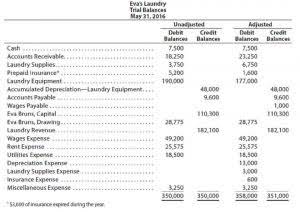Once your WIP inventory turns into sellable goods, you will need a system in place to track inventory as it’s being sold. ShipBob’s technology fully integrates with your store to easily manage all inventory and orders from one central dashboard while they fulfil your orders on your behalf. Generally, the amounts in work-in-process (WIP) are relatively small compared to a manufacturer’s cost of goods sold and its finished goods inventory. The cost of a manufacturer’s work-in-process inventory are to be disclosed in the company’s financial statements. After the work in process inventory has completely been manufactured, it can be sold to a customer as a finished good and is no longer considered a work in process. Raw materials inventory is the raw stock manufacturers order to produce their products.
Increase customer satisfaction
- Implementing inventory management software can enhance accuracy, provide real-time tracking, and streamline production processes.
- MYOB offers robust inventory management and warehouse management solutions to help you identify production bottlenecks, calculate a more accurate business valuation and reduce your WIP inventory.
- For a more in-depth example, let’s say you run a shoe brand with a beginning WIP of $100,000.
- In other words, it is the WIP asset section of the balance sheet of the previous accounting period.
- This metric is pivotal for understanding the efficiency of the manufacturing process and for evaluating how well resources are being utilized.
- On the other hand, ‘work in progress’ is often used in construction and other service businesses and refers to the progress of a project and how much it costs compared to the percentage of completion.
The accountant can then compare the real-world data with the financial metrics to make sure everything checks out. Cloud-based inventory management software offers flexibility and accessibility. These systems allow businesses to manage WIP inventory from anywhere with an internet connection. Features like real-time updates, demand forecasting, and automated reporting make cloud-based solutions invaluable for efficient WIP inventory management. Calculating the value of WIP inventory involves associating a cost with a percentage of completion. This can be a bit time-consuming, so it’s typically best to tally it up at the end of your accounting period to minimize uncertainty on your company’s balance sheet.
Invest in manufacturing automation
Work in progress, on the other hand, usually refers to larger, more complex projects. For example, the construction industry will use work in progress when building a house. Work in progress inventory is typically ‘in progress’ for a lot longer than work in process goods, sometimes spanning several accounting periods. Accurate WIP inventory management also facilitates better financial reporting – helping you to meet your legal obligations and maintain healthy cash flow. This guide covers the work in process inventory formula, how to calculate it, and how to cost-effectively manage your work in process inventory. As with most inventory management KPIs, ensuring an efficient inventory management process is critical to optimizing the work in process inventory.
- Work in progress inventory is typically ‘in progress’ for a lot longer than work in process goods, sometimes spanning several accounting periods.
- The chief advantage of these systems lies in unified access to real-time production data.
- On the other hand, having too little WIP inventory can result in delays as you wait for more materials or components from suppliers, which could ultimately affect customer satisfaction levels.
- With ShipBob’s best-in-class inventory management software, brands can closely monitor inventory.
- First, it reduces costs for us, because we’re shipping more orders a much shorter distance.
- This enhances accuracy in inventory management, reduces errors, and facilitates quick decision-making.
Improved customer satisfaction
Work-in-process inventory refers to items that are in the production process but have not yet been completed or fully assembled. It is a critical part of the inventory lifecycle, as it represents a company’s investment in raw materials and labor that are in various stages of being converted into finished goods. WIP inventory includes products that are in the process of being manufactured but still require further steps such as assembly, testing, or finishing before they can be sold as final products. In WIP inventory accounting, various costs are tracked, including the cost of raw materials, direct labour, and manufacturing overhead such as utilities and depreciation of equipment. These costs are accumulated as goods move through different stages of production.
Work in process (WIP) inventory refers to materials that are waiting to be assembled and sold. WIP inventory includes the cost of raw materials, labor, and overhead costs needed to manufacture a finished product. These types of industries often require multiple stages of production, with significant time and resources invested in each stage, resulting in a higher accumulation of costs in the WIP inventory account. Many ecommerce brands rely on manufacturers for raw materials or finished parts to create finished products. That means that optimizing the supply chain and the work in process inventory KPI involves working closely with manufacturing partners.
In the garment industry, fabric that’s currently being printed, weaved, or dyed would be classified as work-in-process inventory. In the automobile industry, a partially assembled car would meet the criteria. No, work in process starts when human labour interacts with the raw material. Upgrading your machinery and workforce are two of the best ways to reduce WIP in a manufacturing environment.
You can anticipate demand, adjust production schedules accordingly, and avoid overproduction or shortages. It passes through multiple workstations for a different operation to perform systematically after finishing and painting. As the cars move from one department to another, more costs are added to production. ‘Finished goods’ inventory are items that have been completed by the manufacturer and are ready to be sold for revenue. Brands of all sizes and stages can unlock scalable fulfillment solutions with ShipBob.
Leveraging technology for WIP inventory management is crucial in the modern business landscape. Implementing advanced inventory tracking systems, such as barcoding or Radio-Frequency Identification (RFID), provides real-time visibility into the movement of goods. This enhances accuracy in inventory management, reduces errors, and facilitates quick decision-making. Accurately knowing what your WIP inventory is can impact the company’s balance sheet. WIP inventory changes depending on how customizable the products are, what costs go into the product, and how to calculate it correctly for accounting purposes. Some companies do a physical count of their WIP inventory to determine the value based on the current stage of each unit in the manufacturing process.
Find the right balance—not too much WIP inventory, but not too little that it slows production. Join tens of thousands of ecommerce brands to get more articles like this and our latest resources delivered to your inbox. When these work in process inventory example terms are used by businesses selling a physical product, both mean the same thing. ShipBob’s Customization Suite has multiple high-quality features to enhance the unboxing experience.
Ending work-in-process inventory is an important statistic for firms to manage and analyze their production efficiency and costs. Organizations can get insights into their inventory levels by precisely determining the value of partially completed units after a production cycle. Usually, accountants assign all raw materials, gather all labour and overhead costs, and then record the sum of all these costs as an asset entry in the balance sheet. In practice, advanced manufacturers find the COGM and ending WIP values based on real data from their production management system. COGM is found by tallying up the real costs from manufacturing orders as calculated or estimated by the production management tool, whether it’s MRP/ERP software, spreadsheets, or a pen-and-paper approach.
What is the difference between WIP inventory and finished goods inventory?
A complete dining table ready to be packaged and shipped to the customer does not yet exist. Therefore, these parts are classified as work in process inventory until the assembly has finished. At different stages of production, various pieces of the table are coming together. You have the legs carved out, the tabletop sanded and smoothed, and the varnish or paint applied.
Modern technology solutions such as cloud manufacturing software help automate WIP inventory management. Ensure that labour resources are effectively optimised to minimise idle time and maximise productivity. Cross-train employees to perform multiple tasks and adjust staffing levels based on production demands to maintain an optimal balance between labour and production capacity. Work in process inventory accounting is essential for understanding your profit margins and cash flow.
Paying to store too much unsellable inventory can seriously impact a brand’s bottom line—and not in a good way. All of the materials, capital, and time put into making finished goods are counted as «work in process» (WIP). Determine the ending WIP inventory from the previous period and carry it over as the beginning number for the current financial period to compute the beginning WIP inventory. In this article, we’ll look at the concept of WIP inventory, its role in the production cycle, and practical management approaches. Brands of all sizes and stages can unlock scalable fulfilment solutions with ShipBob. From our Growth Plan to global fulfilment capabilities and B2B offerings, ShipBob can help brands reach their goals and continue to grow their business.
Here are five reasons why accurate WIP accounting is a must, regardless of company size. There must be accurate and consistent contact about what’s happening at each stage of the production cycle. Having too much WIP inventory can lead to increased costs due to storage fees, higher labor costs, and slower turnaround times for orders. Strategies include implementing lean manufacturing principles, improving demand forecasting, and enhancing production scheduling. High levels of WIP inventory tie up capital, potentially affecting a company’s liquidity and cash flow. Clear insights into your WIP levels and production cycle times allow for more reliable forecasts and production plans.
Small batches reduce the risk of overproduction, minimize holding costs, and allow for greater flexibility in responding to market changes. Businesses should analyze demand patterns, production capabilities, and market trends to set the most efficient batch sizes. Understanding this distinction helps businesses track costs and optimize production efficiency. Since WIP inventory is an inventory asset, neglecting to include it on your business’ balance sheet can cause your total inventory to be undervalued. For tax purposes, it’s best to track WIP inventory to get an accurate breakdown of what your inventory is actually worth. Then, on the closing day of the month, the company was accounting for the availability of widgets in its inventory and saw that it had only 10,000 widgets.
Work-in-process inventory is a critical element of the manufacturing process, representing the value of products that are in various stages of completion. Understanding the definition, components, formula, and calculation methods for WIP inventory is essential for businesses that rely on job order costing. Accurate tracking and management of WIP inventory help companies optimize their production processes, control costs, and ensure efficient use of resources. By applying effective inventory management strategies, companies can maintain profitability, improve cash flow, and better meet customer demands. The Cost of Goods Manufactured is the total manufacturing cost of goods that have been completed during the accounting period. This metric is pivotal for understanding the efficiency of the manufacturing process and for evaluating how well resources are being utilized.
By working closely with your supplier and other partners in your retail supply chain, like a 3PL company, you can find ways to optimise the supply chain. How much cash is directly necessary for your operation to produce a given item? A cost is considered a direct cost if it is clearly traceable to a specific unit of production. MYOB offers robust inventory management and warehouse management solutions to help you identify production bottlenecks, calculate a more accurate business valuation and reduce your WIP inventory. Generally, work in process refers to manufactured products that move from raw materials to finished products quickly. For example, a bakery with 50 batches of bread in production is a work in process.





